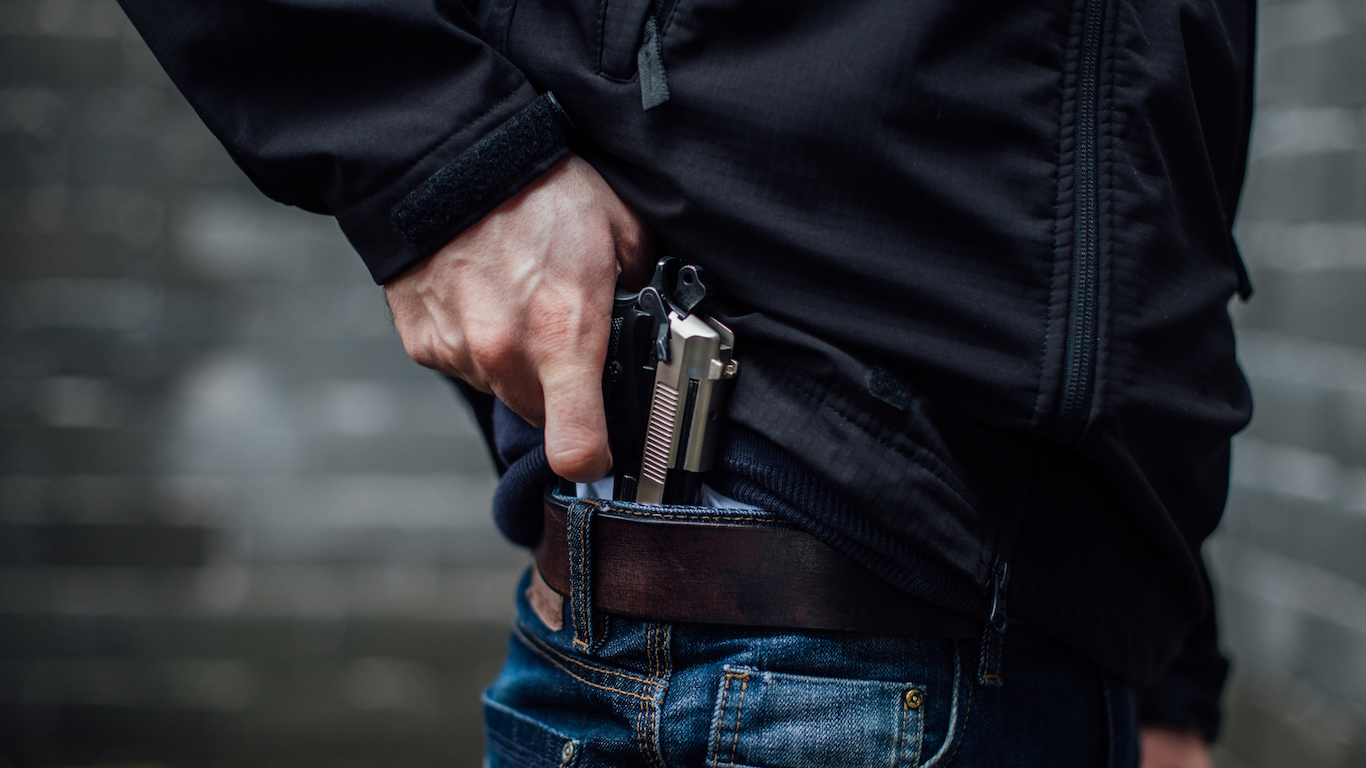Companies and Brands
Do Open Carry Laws Increase or Decrease Gun Violence?

Published:
Last Updated:

Sometime in the past 10 years or so, all of us have heard or read the remark, “The only thing that stops a bad guy with a gun is a good guy with a gun.” National Rifle Association (NRA) Executive Vice President Wayne LaPierre uttered the phrase barely a week after the school shooting at Sandy Hook Elementary School in Newton, Connecticut, that killed 27 children and educators. LaPierre was arguing that to protect the nation’s children, the country needed to station an armed police officer in every U.S. school.
Law enforcement officers are, almost by definition, the good guys, but a fair inference from LaPierre’s statement is that any good citizen with a gun can stop an armed bad one. There is anecdotal evidence of that.
Another possible inference to be drawn from LaPierre’s statement is that carrying a gun is (or should be) legal. Of the 50 states and the District of Columbia, only six ban open carrying of a handgun (California, the District of Columbia, Florida, New York and South Carolina), and only seven ban open carrying of long guns (rifles and shotguns), according to data from the Giffords Law Center. They are California, the District of Columbia, Florida, Illinois, Massachusetts, Minnesota and New Jersey.
Another 20 either require a permit to openly carry a handgun or place some other restriction on open carrying in public places. Only five states (Iowa, Pennsylvania, Tennessee, Utah and Virginia) restrict, but do not prohibit, open carrying of long guns.
In states with open carry laws, law enforcement agencies may not be able quickly to distinguish a real threat from a legal open carry. At a 2016 mass shooting in Dallas in which five police officers were shot and killed, the presence of some 30 people legally carrying long guns made it difficult for police to sort the good guys from the bad.
Unlike laxer open carry rules, carrying a concealed weapon generally requires a state-issued permit in 35 states, while 15 states have no restrictions on concealed carry. Only eight of the 35 states that require permits have enacted what are called “may issue” laws, which grant state authorities wide discretion to deny a concealed carry permit to an applicant. In the other 27 states, authorities “shall issue” a concealed carry permit, and 14 of those the states allow no discretion to the permit-issuing authority.
Note that a 2017 study found that merely seeing a gun can increase aggression. The researchers noted, “[O]ur naïve meta-analytic results indicate that the mere presence of weapons increased aggressive thoughts, hostile appraisals, and aggression, suggesting a cognitive route from weapons to aggression.”
Right-to-carry laws, whether open or concealed, tend to increase violent crime. A 2019 study found that right-to-carry laws “are associated with 13–15 percent higher aggregate violent crime rates 10 years after adoption.” Another study reported in 2017 found that “shall-issue” laws were “significantly associated with 6.5% higher total homicide rates, 8.6% higher firearm homicide rates, and 10.6% higher handgun homicide rates, but were not significantly associated with long-gun or nonfirearm homicide.”
While state laws vary widely, there is one nationwide law that limits open or concealed carrying of firearms. In a federal circuit ruling known as GeorgiaCarry.Org Inc. v. Georgia, the court ruled the right to bear arms granted by the Second Amendment to the U.S. Constitution does not supersede a “fundamental” right to exclude arms from private property. That means that businesses may legally ban firearms and other weapons from their premises. Full stop.
Stores like Target, which in 2014 “respectfully request[ed]” its shoppers to leave their guns at home received heated blowback from some gun owners, have persevered. Others, like Walmart, which itself sells guns in its U.S. stores, have allowed customers to carry guns openly in states where open carry is legal. But Walmart is somewhat of an exception. Gun sales policies have been changing in the country — these are the big American retailers that don’t sell guns.
CNBC has posted a list of unusual places where people can bring a gun. These include most churches (except in some states where concealed carry in churches is banned), casinos in most states, bars and restaurants, most airports (but not airplanes), voter registration and polling places, hospitals, national parks, libraries and several others.
In addition to Target, guns have been banned at cinema chains like AMC, Carmike and Cinemark; eateries like Buffalo Wild Wings, Hooters and Starbucks; and at dozens, if not hundreds, of shopping malls across the country. Simon Property Group, which owns or holds an interest in more than 200 U.S. shopping malls, does not allow firearms at its malls.
Of the 100 largest U.S. retailers last year, just seven sold firearms of any kind. A new study out earlier this year from researchers at Boston University found that the kind of gun control that is most likely to work is one specific type, and it has nothing to do with banning weapons.
Start by taking a quick retirement quiz from SmartAsset that will match you with up to 3 financial advisors that serve your area and beyond in 5 minutes, or less.
Each advisor has been vetted by SmartAsset and is held to a fiduciary standard to act in your best interests.
Here’s how it works:
1. Answer SmartAsset advisor match quiz
2. Review your pre-screened matches at your leisure. Check out the advisors’ profiles.
3. Speak with advisors at no cost to you. Have an introductory call on the phone or introduction in person and choose whom to work with in the future
Thank you for reading! Have some feedback for us?
Contact the 24/7 Wall St. editorial team.